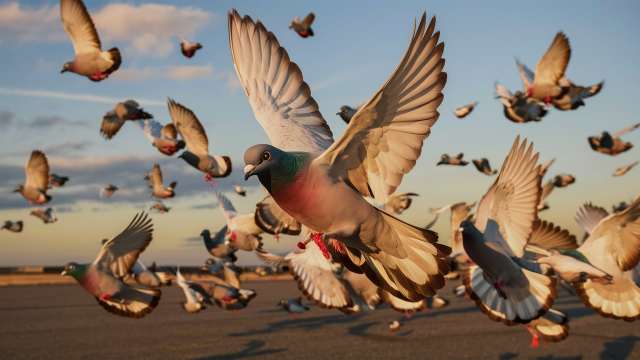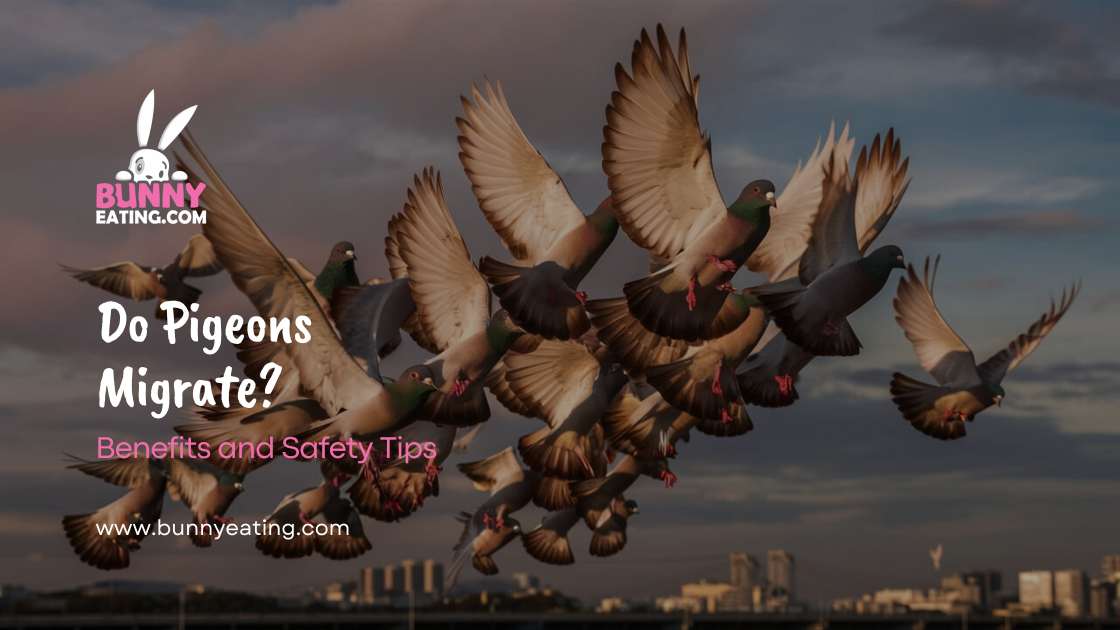The term “pigeon migration” refers to the movement of pigeons across certain distances, which aim at improving their living conditions. In contrast to other avian species that may travel great distances, pigeons usually remain within an area. Seasonal movements or environmental changes could contribute to these migratory patterns. This phrase is used to denote both short-distance as well as far-off travels. Do Pigeons Migrate?
Imagine waking up and having your city swarming with pigeons. This is a sight that raises many queries. Are they lost? Is there anything that can attract them? When it comes to pigeons migrating, understanding why these birds migrate between cities will shed light on the urban birds’ strange habits. Let us look at some of the reasons they could opt to shift locations.
Pigeons have migration tendencies that are different from certain bird species. Instead of travelling long distances, they tend to stay in their immediate vicinity. They may move from one place to another searching for food or the ideal place to lay eggs. Their movements are determined by environmental conditions as well as human interference.
Pigeon Behavior and Lifestyle Overview
The astonishing characteristics which have allowed them to prosper under varied conditions are present in the grey Columba livia also known as pigeons. They come from a background that is intriguing and important in examining them. One should study how they organize themselves as well as what they eat because of these unusual traits that distinguish them from other avian species.
The social ties among pigeons are one of the most remarkable features of their conduct. These birds are often spotted clumped together, foraging and sleeping in huge groups. However, this social disposition is not merely for display purposes; it is vital for their existence as it aids them in sharing information on food and potential dangers. Their ability to establish tight-knit communities has without a doubt helped them to cope with city life situations.
General Behavior and Characteristics
Pigeons are known for their exceptional flying abilities and remarkable homing instincts. These birds can fly at speeds of up to 60 miles per hour and navigate long distances with incredible accuracy. Their homing ability has been utilized by humans for centuries, with pigeons serving as messengers in various cultures throughout history.
Regarding dietary habits, it must be noted that pigeons are opportunistic feeders. They usually feed on seeds and grains in the wild. But, city pigeons have embraced a more diverse menu which may consist of leftovers from human beings. The ability to feed on different things has enabled pigeons to successfully settle in cities all over the world.
Natural Habits of Pigeons
A cliff-dwelling species among pigeons in their initial environment, they built nests on gravelly ledges as well as down under roofs. It is precisely this inclination for lofty positions covered from view that accounts for their love of sitting atop buildings’ ledges and window sills in town areas. Adjusting nesting behaviour to fit buildings facilitated this bird’s rise within cities.
On most mundane days, a pigeon can be found doing things like looking for food, grooming itself as well as mingling with its peers. This type of bird does its mostly energy-consuming activities during the day that is from dawn until dusk they will be up and about. The ability of pigeons to fly greatly relies on their feather maintenance through regular taking a bath.

Pigeon Migration: Facts and Myths
When we talk about bird migration, we often think of species that undertake long, seasonal journeys across continents. However, the story of pigeon migration is quite different and often misunderstood. Let’s dive into what migration really means and how it applies – or doesn’t apply – to pigeons.
Migration, in the context of birds, refers to the regular, seasonal movement between breeding and non-breeding grounds. These journeys can span thousands of miles and are typically driven by changes in food availability, habitat conditions, or weather patterns. But do pigeons fit into this category of migratory birds? The answer might surprise you.
Defining Migration
True migration involves a predictable, cyclical movement of an entire population or a significant portion of it. This movement is typically triggered by environmental cues and involves crossing ecological barriers like oceans or deserts. Migratory birds often undergo physiological changes to prepare for these long journeys, such as accumulating fat reserves.
However, not all bird movements qualify as migration. Local movements in search of food or better shelter are not considered migration. This distinction is crucial when we consider the behavior of pigeons, as their movements often fall into this latter category.
Do Pigeons Actually Migrate?
The short answer is: no, pigeons typically don’t migrate. Instead, they exhibit a behavior known as philopatry, which means they tend to stay in or return to their home area. This behavior is quite different from the long-distance seasonal movements we associate with migratory birds.
Pigeons are what we call sedentary birds. They generally stay in the same area year-round, adapting to seasonal changes rather than fleeing from them. This doesn’t mean they never move – pigeons can and do travel in search of food or better nesting sites. However, these movements are usually local and don’t follow the predictable, long-distance patterns of true migration.
Comparison with Other Birds
To truly understand why pigeons don’t migrate, it’s helpful to compare them with birds that do. Let’s look at some examples and see how pigeon behaviour differs from that of migratory species.
Migration Patterns in Other Birds
Many bird species undertake impressive migratory journeys. For instance, the Arctic Tern flies from the Arctic to the Antarctic and back each year, covering a distance of about 44,000 miles. The Bar-tailed Godwit can fly non-stop for nine days over the Pacific Ocean during its migration.
Development of specific adaptations for their lengthy trips has happened among these less-understood migratory birds. Such birds possess longer, more pointed wings which are ideal for gliding in the air and they can accumulate huge amounts of fat as energy reserve. Their bodies transform due to hormonal fluctuations that cause hyperactivity during the scheduled period of migration also referred as Zugunruhe.

Contrast with Pigeons
In stark contrast, pigeons don’t exhibit these migratory adaptations. Their bodies aren’t designed for long-distance flights in the same way as true migratory birds. Instead, pigeons have evolved to be highly adaptable to various environments, which allows them to thrive year-round in one location.
By their talent in discovering food in various situations, adaptability to different temperature ranges, and ability to adapt man-made buildings for resting, pigeons have become static birds. As a result of these features, they experience great success in towns, where all necessary things are available within a short distance.
Factors That Influence Pigeon Movements
While pigeons don’t migrate in the traditional sense, their movements are influenced by various factors. Understanding these can give us insight into pigeons behaviour and how they interact with their environment. Let’s explore the key elements that affect pigeon movements throughout the year.
From seasonal changes to food availability, several factors play a role in determining where and when pigeons move. These influences shape the daily and seasonal patterns of pigeon activity, contributing to their successful adaptation to diverse habitats, especially in urban areas.
Seasonal Changes and Pigeon Behavior
Although pigeons don’t migrate with the seasons, their behaviour does change throughout the year. These changes are often subtle but play a crucial role in their survival and reproductive success. Understanding these seasonal patterns can help us better appreciate the adaptability of these common urban birds.
In winter, pigeons may become less active and spend more time roosting to conserve energy. They might also gather in larger groups to share body heat. As spring approaches, pigeon activity increases. This is when breeding season begins, and you might notice more courtship behaviors and nest-building activities. Summer sees pigeons at their most active, with plenty of food available and long daylight hours for foraging. In autumn, pigeons may spend more time feeding to build up fat reserves for the coming winter.
Other Factors Affecting Pigeon Movements
Beyond seasonal changes, several other factors influence pigeon movements. Food availability is perhaps the most significant. Pigeons are opportunistic feeders and will move to areas where food is plentiful. In urban areas, this might mean frequenting parks where people feed birds, or areas near restaurants with outdoor seating.
Water sources are another crucial factor. Pigeons need regular access to water for drinking and bathing, so they tend to stay near reliable water sources. Safety is also a key consideration. Pigeons will avoid areas where they frequently encounter predators or other threats. In cities, this might mean moving away from areas with a high concentration of birds of prey or where anti-pigeon measures have been implemented.

Pigeons in Urban Areas
Urban pigeons have become a common sight in cities around the world. These birds, often referred to as “rock doves,” have adapted remarkably well to life in human-dominated landscapes. Their success in urban environments offers a fascinating case study in animal adaptation and raises interesting questions about urban wildlife management.
From New York to Tokyo, pigeons have made themselves at home among skyscrapers and bustling streets. They’ve learned to navigate the unique challenges and opportunities presented by city life, developing behaviors that differ significantly from their rural counterparts. Let’s explore how urban living has shaped pigeon behavior and what it means for their movement patterns.
Differences in Behavior
City pigeons exhibit some notable differences in behaviour compared to their rural relatives. One of the most obvious is their comfort around humans. Urban pigeons have become habituated to the constant presence of people, often approaching quite closely in search of food. This boldness is a learned behaviour that helps them take advantage of human food sources.
Another key difference is in their foraging habits. While rural pigeons primarily feed on seeds and grains, urban pigeons have a much more varied diet. They’ve learned to eat a wide range of human foods, from bread crumbs to discarded fast food. This adaptability in diet has been crucial to their urban success. Urban pigeons also tend to have larger clutch sizes and breed more frequently than their rural counterparts, likely due to the year-round availability of food in cities.
The Effect of Urban Environment on Pigeon Migration
The urban environment has had a profound effect on pigeon movement patterns. It’s one of the main reasons why urban pigeons don’t migrate. Cities provide everything pigeons need to survive year-round, eliminating the need for seasonal movements.
Buildings present several protected ledges suitable for bird nests just like the rocky cliffs where pigeons first dwelt. Moreover, urban centres are usually warmer relative to their neighbouring countryside thus creating more conducive environments for these birds during harsh icy months. In addition, pigeons can always find food at any time thanks to waste thrown away by humans or intentional feeding; consequently, they do not have to migrate in search of sustenance according to seasonal changes.
Conclusion
Do Pigeons Migrate?” Yes, pigeons do migrate, but they do not travel long distances like some other birds. They often move within their local area to find better food and shelter. Their migration is more about finding nearby resources than travelling far away.
Gaining insight into the migration of pigeons informs one on how they adapt to their environments. The movements of the birds may be determined by their basic needs such as the search for new nesting sites. Therefore, we get a grasp of what these birds do to fit into different settings and continue surviving in them by studying these patterns.
FAQs
Where do pigeons go in winter?
Pigeons generally stay in the same area during winter as they are well-adapted to cold weather. They might seek shelter in warmer, urban environments.
Do pigeons always stay in the same place?
Pigeons are highly territorial and often stay in the same place, especially if there’s a reliable food source.
Why do pigeons suddenly fly away?
Pigeons suddenly fly away due to perceived threats, loud noises, or disturbances in their environment.
Why do pigeons suddenly disappear?
Pigeons may disappear due to changes in their habitat, food scarcity, or migration to nearby areas with better conditions.











